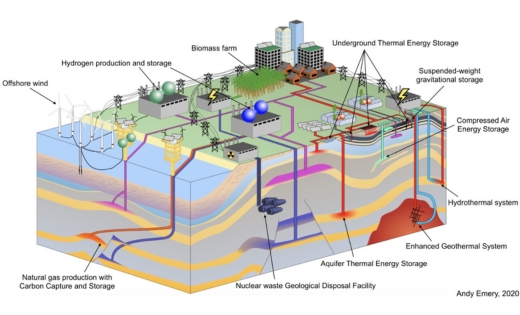Geoscience – clean energy beneath our feet
Professor Sandra Piazolo and Dr Rachael Spraggs explain how a game-changing revolution to discover new sources of clean energy deep below the surface of the earth is underway at the University.

At the University’s School of Earth and Environment, we are pivoting away from geological research that has historic ties with the fossil fuel industry.
Reorienting our research into clean energy is a fundamental objective set out under the University’s ambitious Climate Plan.
Given the impacts of global warming, we must find the bridge to a low carbon future in which we can generate new clean and renewable energy sources, and ensure we can distribute and store that energy effectively.
Techniques, datasets, knowledge and expertise we already have at the University will help us to identify and minimise the risks of subsurface energy projects, including geothermal.
Under the University’s Climate Plan, £2.8m is being invested in our Geosolutions centre. It brings together research, study and collaboration into subsurface technologies across many disciplines including geologists, engineers and social scientists.
We have a high level of confidence that sub-surface geothermal energy is a solution for a more sustainable future – the challenge is to produce the data to support this and encourage the investment necessary to make it a large-scale green energy resource.
We can be part of the solution by making use of our own campus as a living laboratory for our researchers and students.
Let’s take a step back and put this into context: the demand for heat is responsible for around 37% of UK carbon dioxide emissions — about 80% of our heat comes from natural gas.
Proving the case for heat and energy extraction from geothermal sources alongside other green technologies like wind, solar and hydro will be a game-changer for energy companies.
Our focus at Geosolutions Leeds is to reorient our research to provide the evidence that industry and policymakers need to integrate geothermal into their planning for ecological and commercial benefit.
It can provide a solution to hydrogen and CO2 storage, heat storage and heat and energy extraction, as well as the minerals required for net zero technologies and subsurface knowledge for wind and hydro power installations.
Focused research
Huge stores of heat far below the surface of the Earth are still a largely untapped renewable energy source. There are a few places in the world where the right combination of geological conditions allows hot water to bubble naturally to the surface, meaning it can be readily used as a source of geothermal energy.
Elsewhere, however, it is necessary to drill deep into the Earth’s crust to tap into this constant, renewable supply of heat energy. Such activities can be expensive and fraught with complications. Local geology and hydrology at each location determines how deep boreholes need to be drilled, how easy it will be to circulate water through the rock, and how long a geothermal plant may remain operational for.
One of our research teams is using its expertise to fill crucial knowledge gaps about how fluids flow in carbonate rocks, and how fault systems affect this.
Our geotechnical engineering expertise at Leeds is also exploring the most viable storage systems, such as disused mines and lined rock caverns. This will help to address some of the challenges experienced by other renewable energy sources, such as offshore wind.
Offshore wind is growing rapidly but the output is intermittent, with electricity often generated at times of low demand. Subsurface alternatives offers a sustainable way to store this excess energy, following conversion into hydrogen or compressed air, which can then be accessed to run turbines when demand is high.
Our fast-track subsurface net zero project which began last September will run for five years. Focused research will boost our global credibility, helping to attract further funding from bodies like UKRI and generate partnership interest from energy companies who are looking to transition from fossil fuels to renewables.
It also offers the prospect of reducing the University’s carbon footprint, by providing an alternative energy source that can be used to power and heat our buildings, thereby cutting our carbon emissions.
This following visual illustration shows many ways the subsurface can contribute to decarbonisation of our energy systems.
 Diagram outlining the generation of energy from sub-surface sources
Diagram outlining the generation of energy from sub-surface sources
The University's initial funding is aimed at appointing a demonstrable leader in the field and upskilling existing staff, giving them the space and support to focus on net zero research and further develop Geosolutions into an internationally recognised centre of excellence in low carbon subsurface energy solutions.
By reorienting our research we will also be training the next generation of geoscientists and engineers through world class MSc and PhD programmes.
Read more about the Geosolutions centre.
The University of Leeds’s Climate Plan
At £174 million, the University of Leeds’s ambitious Climate Plan represents the biggest investment we have ever made, with seven key principles highlighting our commitment to net zero emissions, a sustainable curriculum, responsible investment and reorienting postgraduate research and teaching away from the fossil fuel sector.
Posted in: University news